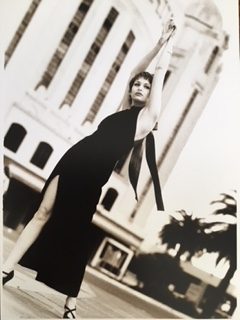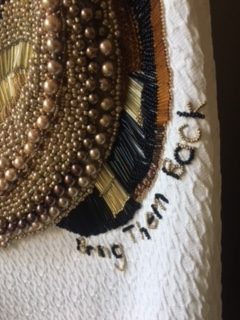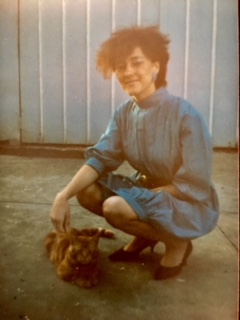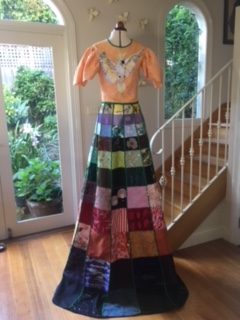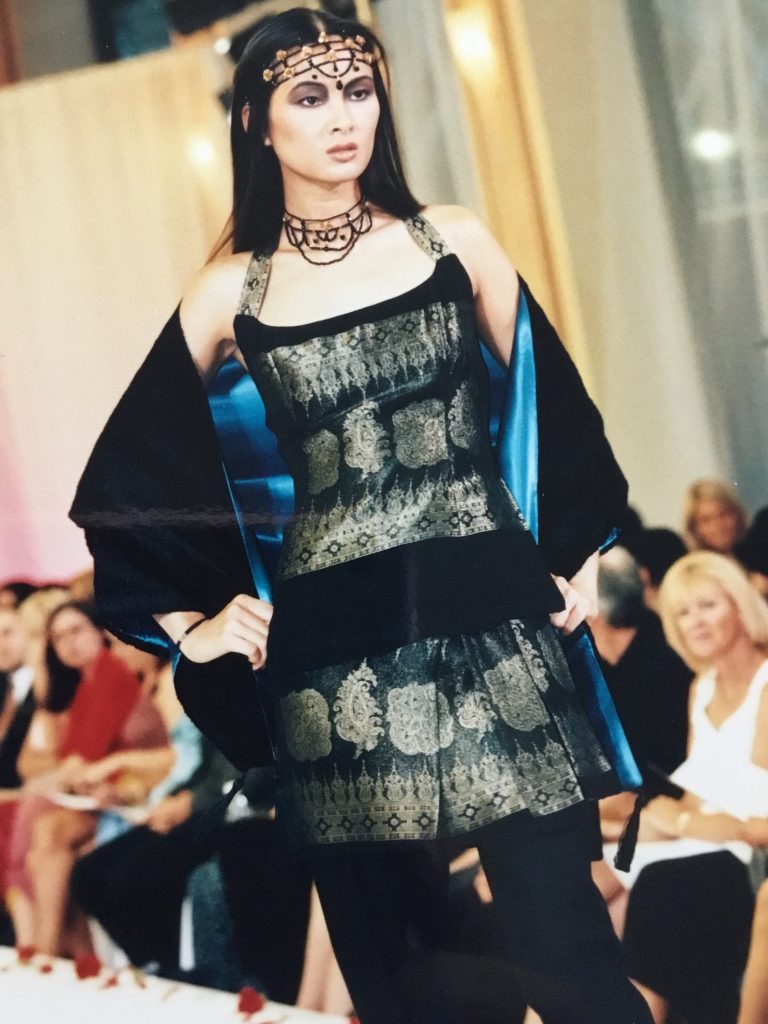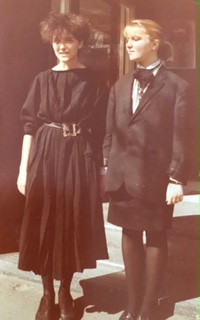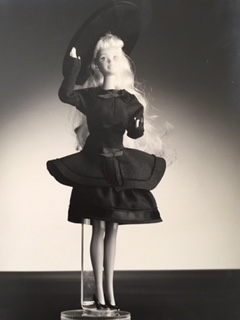Fashion, creativity and rebirth
Fashion, creativity and rebirth
Victoria Triantafyllou is a designer who has worked in the fashion industry for over 30 years. Born to first-generation Greek migrants with little education, she was part of the thriving alternative fashion scene in the 1980s.
She became one of Melbourne’s original indie designers, with works held in the National Gallery of Victoria. The established designer then walked away from wholesale and retail outlets to work as an individual in her own creative practice.
Born into Greek Melbourne
Victoria Triantafyllou’s parents met and married in Melbourne in 1963. They both came from central Greece, her father from a tobacco farming and fishing area, her mother from the mountains. With limited education, they left a country ravaged by war and came to join relatives in Melbourne.
Like many others in the Greek community, they gathered in Fitzroy and Richmond. During the week, they worked in factories, her father at General Motors Holden. Their social life rested on taking a plate of food to a friend or relative’s house, where they would sing and dance together.
The first generation Australian grew up in the midst of this Greek community. She learnt to embroider by watching the Greek women sit together during many afternoons knitting, working on needlepoint or crochet. Her mum had great talent in handcrafts. Triantafyllou gained her craft from the skills taught to her by these women. Around age 10 she began to use a sewing machine to make clothes for her dolls.
A suburban social life
The family moved from Richmond to Chadstone and it was a culture shock. Triantafyllou found new connections in the local community, borrowed a sewing machine and kept going.
By age 17, she was making clothes for herself and others, including some memorable green vinyl hipster pants.
It was a vibrant time in Melbourne. The designer remembers how on weekends, all the creative young people would stream out of the suburbs and meet in St Kilda or the city. They would parade in the clothes they’d made themselves. It’s a time Triantafyllou thinks has been lost…
Triantafyllou’s parents hoped she would become a schoolteacher, which they considered a respectable profession and a good career path for women. Triantafyllou had different plans. With her perm and rats tail, she dreamt of a career in fashion. She reflects:
“You have to be strong enough to take your path. To make your path. This was my calling.”
Halcyon days at RMIT
Triantafyllou followed her passion and went to fashion school at RMIT. From the beginning, she knew she didn’t want to churn out mass-produced clothes.
At the end of her second year, she set up a stall at Queen Vic Market on a Sunday to sell her clothes. She made more commercial stuff, but with a twist.
She liked to use menswear fabric in women’s clothes. It was the height of the 80s and her clothes were a refreshing alternative to most of what was available. People were coming and buying.
Around that time she was invited to join the Fashion Design Council of Australia, an organisation that promoted young, independent fashion designers. The FDC organised annual fashion extravaganzas, at places including The Venue, St.Kilda. This drew her into a world of more highbrow fashion.
“People would come and see us. We were featured in Crowd Magazine, Stiletto Magazine” She remembers fondly how she used to find models on the street:
“I’d approach interesting looking women from diverse cultural backgrounds. Anyone who looked elegant.”
Building a business
After RMIT, in 1985 Triantafyllou rented a small studio in Little Collins Street. There were two small rooms and it cost her $65 per week in rent. She designed ‘made to order’ outfits and fulfilled wholesale orders nationally. She started to employ people, though Triantafylloualways did the pattern making and cutting, they would do the sewing. She continued to use menswear fabrics, which were part of her distinct look as well as durable. Designed to last.
“It was a reaction against mainstream fashion and there was a market for it. And it worked. People loved it. There were cleaner lines, it was more classic with a modern edge. It was a lot more interesting than the bright coloured rayon, shiny parachute silk that was out there.”
Triantafyllou became one of Melbourne’s original indie designers, part of a thriving fashion scene at a time of creativity and freedom.
Growing a label
Triantafyllou wholesaled her collections nationally for almost a decade before opening her first boutique in Chapel St, South Yarra. Then subsequently Little Collins St, Melbourne and Malvern Rd, Prahran East.
It was a natural progression to open her retail outlet in 1993. Wholesaling her collections at that time was proving more difficult. She found that businesses would order and not pay, sometimes for substantial orders. She remembers a customer pulling out of a $20,000 order of clothes and the pressure she was under to find creative ways to move the stock on.
She held an open studio from a simple A-board on the street inviting people in.
She looks back, “I wanted to have more control, creative as well as financial, but there was a lot of risk involved. I created a beautiful space, merchandised my creations and displayed beautiful windows. It was interesting selling limited edition pieces. At the time Chapel Street was a major destination and melting pot for independent, unique fashion. It was groovy – the place to go. But over time it went too mainstream and the rents went through the roof.”
There was trouble in the CBD too. Drug culture that kept people away now surrounded her boutique in Little Collins Street.
Reaching her limit
Next Triantafyllou started to get involved in bigger festivals, Melbourne Fashion Week, Spring Fashion Festival, which translated to a lot of high end sales. She also opened another store in Hawksburn Village. She had started to spread herself too thinly.
“I had two young kids. Juggling it all made it a crazy time. I was working within the season as well as a season ahead, creating fashion shows, finding publicity and sponsors. Over time, creativity became less of the picture. There was more paperwork and logistics.
By the time my children were aged 8 and 5, it was getting harder and harder. We were competing with fast fashion coming out of China. I couldn’t see my next move. I was burnt out.”
Triantafyllou walked away from it all. She spent the next few years being a stay at home mum. At first she rejected any design work, though she dabbled in helping people buy clothes, putting together seasonal wardrobes. A friend asked her to make a wedding dress for her daughter. From that process she re-claimed her passion.
After a break of seven years, Triantafyllou now only works for private commissions as a made to measure designer.
She found that she could be really creative as well as able to concentrate on the craft, tailoring, fit and workmanship, making things that you couldn’t buy anywhere else. She made clothes for women going to the races and other beautiful outfits for special occasions . Every piece is outstanding and exceptional. It became a word of mouth business.
NGV acquisitions
Triantafyllou was approached by the Fashion and Textile curators at the NGV to document those key days of the Fashion Design Council. She had preserved everything in great condition.
The NGV holds six of her outfits in their permanent collection of fashion and textiles of which one was on display during the 200 years of Australian Fashion exhibition, representing the 1980s.
Fashion Unites
Triantafyllou has created a bespoke new work for the 2021 Fashion Unites catwalk film. She explains:
“The dress submitted for Fashion Unites draws inspiration directly from my Greek cultural heritage. The intricately beaded, Greek goddess Athena adorns the front of the dress with the words of the famous manifesto championed by the cultural icon Melina Mercouri, Bring Them Back.”
This is a reference to bringing the Parthenon sculptures back to Greece.
She created an additional dress during the lockdown, using scraps of materials that she had gathered. This harks back to the earlier era when she learned to sew alongside the Greek women who had survived the war, and who made do with what they had. Fittingly, the dress was shown in a glass capsule at Queen Victoria Market as part of an effort to invite Melburnians back to the city.
She reflects that the time spent during lockdown away from the busy-ness of pre-pandemic life reminded her of an earlier simple time in her youth.
All of Triantafyllou’s work is sustainable and durable, it’s the antidote to fast fashion. She’s still pursuing the same values she held when she began as a student almost forty years ago.
Watch the Fashion Unites film featuring Triantafyllou’s work here.
Sara Tiefenbrun writing for Multicultural Museums Victoria, 2021

